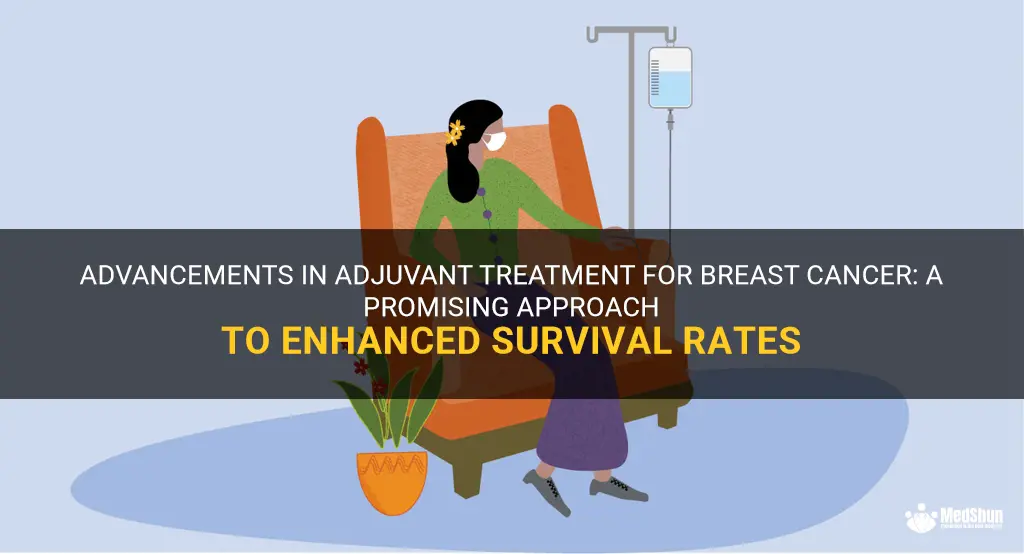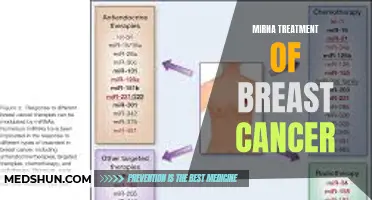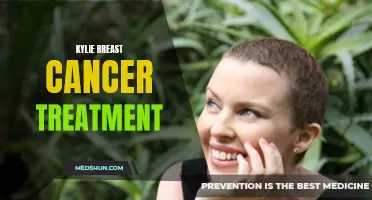
Breast cancer is a formidable adversary, affecting millions of women worldwide. While early detection and surgery are crucial in treating this disease, adjuvant therapy is an equally vital component in the battle against breast cancer. This comprehensive treatment approach, which includes chemotherapy, hormone therapy, and targeted therapies, aims to eradicate any remaining cancer cells and reduce the risk of recurrence. By understanding the role of adjuvant treatment in breast cancer care, we can empower patients and healthcare professionals alike to make informed decisions and achieve better outcomes in the fight against this devastating disease.
| Characteristics | Values |
|---|---|
| Definition | Additional treatment after surgery |
| Purpose | Prevent recurrence |
| Types | Chemotherapy, radiation therapy |
| Timing | After surgery |
| Duration | Varies depending on treatment |
| Side effects | Fatigue, nausea, hair loss |
| Efficacy | Reduces risk of recurrence |
| Administration | Usually given in cycles |
| Cost | Varies depending on treatment |
| Availability | Widely available |
What You'll Learn
- What is adjuvant treatment for breast cancer and why is it recommended after surgery?
- What are the different types of adjuvant treatments available for breast cancer?
- How long does adjuvant treatment typically last for breast cancer patients?
- What are the potential side effects and risks of adjuvant treatment for breast cancer?
- Are there any alternative or complementary therapies that can be used alongside adjuvant treatment for breast cancer?

What is adjuvant treatment for breast cancer and why is it recommended after surgery?
Adjuvant treatment is a crucial part of breast cancer management. It is recommended after surgery to improve outcomes and reduce the risk of cancer recurrence. In this article, we will explore what adjuvant treatment for breast cancer is and why it is important.
Breast cancer is the most common cancer among women worldwide, and surgical removal of the tumor is the standard initial treatment. However, surgery alone may not be sufficient to eliminate all cancer cells. Adjuvant treatment consists of additional therapies given after surgery to target any remaining cancer cells that may be undetectable. It aims to lower the risk of cancer recurrence, improve survival rates, and increase the chances of a cure.
There are several types of adjuvant treatments for breast cancer, including chemotherapy, radiation therapy, hormone therapy, and targeted therapy. The choice of treatment depends on several factors, such as the stage and characteristics of the tumor, age, overall health, and individual preferences.
Chemotherapy is commonly used in the adjuvant setting for breast cancer. It involves the use of powerful drugs that kill rapidly dividing cancer cells. Chemotherapy can be administered before or after surgery, and it helps to destroy any cancer cells that may have spread to other parts of the body. Though chemotherapy may have side effects, such as hair loss, nausea, and fatigue, its benefits in preventing cancer recurrence outweigh the temporary discomfort.
Radiation therapy is another essential adjuvant treatment for breast cancer. It uses high-energy X-rays or other types of radiation to target cancer cells in the breast or surrounding tissues. Radiation therapy may follow surgery to destroy any remaining cancer cells and reduce the risk of local recurrence. It typically involves daily treatments over a period of several weeks but is generally well-tolerated.
Hormone therapy is recommended for patients with hormone receptor-positive breast cancer. This form of adjuvant treatment targets the hormones estrogen and progesterone, which fuel the growth of certain breast cancer cells. Hormone therapy aims to lower hormone levels or block their effects on cancer cells, reducing the risk of recurrence. It may involve the use of medications such as tamoxifen, aromatase inhibitors, or ovarian suppression.
Targeted therapy is another option for adjuvant treatment in breast cancer patients. It involves drugs that specifically target cancer cells with particular characteristics, such as overactive growth signals or HER2-positive tumors. The goal of targeted therapy is to stop or slow down cancer cell growth, prevent recurrence, and improve survival rates.
Adjuvant treatment is recommended after surgery for several reasons. First, it aims to eliminate any remaining cancer cells that may have spread beyond the primary tumor. Even if the tumor is removed entirely, there is always a risk that microscopic cancer cells have already entered the bloodstream or lymphatic system. Adjuvant therapies reduce this risk and therefore improve outcomes.
Second, adjuvant treatment can help prevent the development of metastatic disease. Metastasis occurs when cancer cells spread from the primary tumor to distant organs, such as the lungs, liver, or bones. Adjuvant therapies target potential sites of metastasis and reduce the risk of cancer spreading.
Lastly, adjuvant treatment can improve overall survival rates. By targeting any remaining cancer cells and reducing the risk of recurrence, adjuvant therapies increase the chances of a cure and long-term survival.
In conclusion, adjuvant treatment is a crucial part of breast cancer management. It involves additional therapies such as chemotherapy, radiation therapy, hormone therapy, or targeted therapy, given after surgery to target any remaining cancer cells and reduce the risk of recurrence. Adjuvant treatment aims to improve outcomes, prevent metastasis, and increase overall survival rates. Patients should discuss the potential benefits and side effects of adjuvant treatment with their healthcare team to make informed decisions about their treatment plan.
The Potential Benefits of Anti-Hormone Treatment for Breast Cancer Patients
You may want to see also

What are the different types of adjuvant treatments available for breast cancer?
Breast cancer is one of the most common types of cancer that affects women worldwide. It is a complex disease that requires a multidisciplinary approach for its treatment. Apart from surgery, adjuvant treatments play a crucial role in reducing the risk of recurrence and improving the overall survival rate in patients with breast cancer. Adjuvant treatments refer to additional therapies given after the primary treatment, which is usually surgery, to kill any remaining cancer cells or reduce the chances of the cancer coming back.
There are several types of adjuvant treatments available for breast cancer, and the choice of therapy depends on various factors such as the stage of cancer, the type of breast cancer, hormone receptor status, and the individual patient's overall health. Some of the commonly used adjuvant treatments for breast cancer include chemotherapy, radiation therapy, targeted therapy, and hormonal therapy.
Chemotherapy is a systemic treatment that uses drugs to kill cancer cells throughout the body. It is usually recommended for patients with aggressive breast cancer or those at high risk of recurrence. Chemotherapy can be given before or after surgery, and the duration and type of drugs used vary depending on the individual patient's condition. Common side effects of chemotherapy include hair loss, nausea, fatigue, and an increased risk of infection.
Radiation therapy is another adjuvant treatment option for breast cancer. It involves the use of high-energy X-rays to target and kill cancer cells that may have been left behind after surgery. Radiation therapy is often given after surgery to destroy any remaining cancer cells in the breast or nearby lymph nodes. The treatment is usually administered daily, over a period of several weeks. Side effects of radiation therapy may include skin redness, fatigue, and breast swelling.
Targeted therapy is a type of adjuvant treatment that uses drugs to specifically target certain genes or proteins in cancer cells. It is usually recommended for breast cancer patients who have overexpressed HER2, a protein that promotes the growth of cancer cells. Targeted therapy drugs like trastuzumab (Herceptin) and pertuzumab (Perjeta) can help block the HER2 protein and slow down or stop the growth of cancer cells. These drugs are typically given along with chemotherapy or after completion of chemotherapy. Common side effects of targeted therapies include heart problems, diarrhea, and rash.
Hormonal therapy is a common adjuvant treatment option for breast cancer patients whose tumors have hormone receptors, such as estrogen or progesterone receptors. Hormonal therapy drugs work by blocking or inhibiting the effects of estrogen on cancer cells, thereby reducing the risk of cancer recurrence. Examples of hormonal therapy drugs include tamoxifen, aromatase inhibitors (such as anastrozole and letrozole), and ovarian suppression medications. The duration and type of hormonal therapy depend on various factors, including the patient's menopausal status and the stage of cancer. Side effects of hormonal therapy may include hot flashes, vaginal dryness, and bone thinning.
In conclusion, adjuvant treatments for breast cancer are essential in reducing the risk of recurrence and improving survival rates. The choice of therapy depends on various factors and should be tailored to each individual patient. Chemotherapy, radiation therapy, targeted therapy, and hormonal therapy are some of the commonly used adjuvant treatments for breast cancer. These treatments may have side effects, and it is important for patients to discuss the potential benefits and risks with their healthcare team to make informed decisions about their treatment plan.
The Role of Hormone Treatment in Breast Cancer Surgery Recovery
You may want to see also

How long does adjuvant treatment typically last for breast cancer patients?
Adjuvant treatment is an essential part of the care plan for many breast cancer patients. It is typically recommended for patients with early-stage breast cancer who have undergone surgery to remove the tumor. Adjuvant treatment is given after surgery to help prevent the cancer from coming back and to improve long-term survival.
The duration of adjuvant treatment for breast cancer can vary depending on several factors, including the specific treatment regimen and the individual patient's circumstances. Generally, adjuvant treatment can last anywhere from a few months to several years.
In breast cancer, the two most commonly used types of adjuvant treatment are chemotherapy and hormonal therapy. Chemotherapy involves the use of drugs to kill cancer cells throughout the body, while hormonal therapy aims to block the effects of hormones, such as estrogen, on breast cancer cells.
For patients undergoing chemotherapy, the duration of treatment is typically measured in cycles. Each cycle generally lasts about three to four weeks, with several weeks of rest in between. The total number of cycles recommended will depend on the specific chemotherapy regimen and the patient's response to treatment. In general, adjuvant chemotherapy for breast cancer lasts between four to six months.
Hormonal therapy, on the other hand, is an ongoing treatment that can last for several years. The duration of hormonal therapy is determined by factors such as the type of hormone receptor-positive breast cancer, the presence of menopausal symptoms, and the patient's individual risk of recurrence. Common hormonal therapies for breast cancer include tamoxifen, aromatase inhibitors, and ovarian suppression.
For example, in postmenopausal women with hormone receptor-positive breast cancer, the standard adjuvant hormonal therapy is typically five to ten years of treatment with an aromatase inhibitor. This helps to block the production of estrogen in the body, reducing the risk of the cancer coming back.
It's important to note that the duration of adjuvant treatment can vary from patient to patient. Factors such as the stage of the cancer, the individual's overall health, and any adverse effects experienced during treatment can influence the recommended length of therapy. Therefore, it is crucial for patients to discuss their treatment plans with their healthcare team to understand the expected duration and potential side effects.
In conclusion, the duration of adjuvant treatment for breast cancer can range from a few months to several years. The specific length of treatment will depend on the type of treatment being used, the individual patient's circumstances, and their response to therapy. Adjuvant treatment plays a crucial role in reducing the risk of cancer recurrence and improving long-term survival for breast cancer patients.
The Game-Changer: First Line Treatments for Metastatic Breast Cancer Revolutionize Patient Outcomes
You may want to see also

What are the potential side effects and risks of adjuvant treatment for breast cancer?
Adjuvant treatment for breast cancer is a crucial step in improving outcomes for patients. These treatments, which include chemotherapy, radiation therapy, hormone therapy, and targeted therapies, are administered after surgery to destroy any remaining cancer cells and reduce the risk of recurrence. While adjuvant treatment can be highly effective, it is important for patients to be aware of the potential side effects and risks associated with these therapies.
Chemotherapy is a common form of adjuvant treatment for breast cancer. It uses drugs to destroy cancer cells that may have spread beyond the original tumor. However, chemotherapy can also cause several unwanted side effects. These may include hair loss, fatigue, nausea, vomiting, and an increased risk of infections. Some chemotherapy drugs can also damage the heart, ovaries, or kidneys. Patients should discuss the potential side effects of specific chemotherapy regimens with their healthcare team.
Radiation therapy is another common adjuvant treatment for breast cancer. It uses high-energy X-rays or other types of radiation to kill cancer cells. While radiation therapy is generally well-tolerated, it can cause side effects such as fatigue, skin changes (such as redness or irritation at the treatment site), and breast swelling or tenderness. In rare cases, radiation therapy can also increase the risk of developing a secondary cancer later in life. However, the benefits of radiation therapy in reducing the risk of cancer recurrence usually outweigh these risks.
Hormone therapy is often recommended for patients with hormone receptor-positive breast cancer. This type of therapy aims to block the effects of estrogen or lower estrogen levels in the body. Hormone therapy can cause side effects such as hot flashes, joint pain, and mood swings. It can also increase the risk of developing blood clots or uterine cancer in some patients. However, these risks are generally low, and hormone therapy is considered safe and effective for most patients with hormone receptor-positive breast cancer.
Targeted therapies are a newer form of adjuvant treatment for breast cancer that specifically target cancer cells based on their unique characteristics. These therapies can be highly effective and generally have fewer side effects compared to chemotherapy. However, targeted therapies can still cause side effects such as fatigue, nausea, and skin rash. In rare cases, they may also increase the risk of heart problems or lung damage. It is important for patients to discuss the potential side effects of targeted therapies with their healthcare team, as well as any pre-existing conditions that may affect their suitability for these treatments.
Overall, the side effects and risks of adjuvant treatment for breast cancer vary depending on the specific treatments used and the individual patient. It is important for patients to have open and honest discussions with their healthcare team about the potential risks and benefits of adjuvant treatment. By understanding these risks, patients can make informed decisions about their treatment plans and take steps to manage or minimize any potential side effects. With appropriate monitoring and support, adjuvant treatment can greatly improve the long-term outlook for patients with breast cancer.
Understanding the Different Treatment Options for Pt1c Breast Cancer
You may want to see also

Are there any alternative or complementary therapies that can be used alongside adjuvant treatment for breast cancer?
Breast cancer is one of the most common types of cancer affecting women worldwide. Adjuvant treatments such as chemotherapy, radiation therapy, and hormone therapy are often prescribed to patients after surgery to reduce the risk of cancer recurrence. While these treatments can be highly effective, they can also have side effects and may not address all aspects of a patient's well-being. This has led some individuals to seek alternative or complementary therapies to be used alongside adjuvant treatment for breast cancer.
Alternative therapies are treatments that are used in place of conventional medical treatments, while complementary therapies are used in addition to conventional treatments. It is important to note that while these therapies may offer benefits, they should always be discussed with a healthcare professional to ensure safety and effectiveness.
One alternative therapy that has gained attention in recent years is acupuncture. Acupuncture is an ancient Chinese medical practice that involves inserting thin needles into specific points on the body. It is believed to stimulate the flow of energy and restore balance in the body. Studies have shown that acupuncture can help alleviate some of the side effects of chemotherapy, radiation therapy, and hormone therapy, such as nausea, fatigue, and pain. It can also improve overall well-being and quality of life in breast cancer patients.
Another complementary therapy that can be used alongside adjuvant treatment is massage therapy. Massage therapy involves manipulating the muscles and soft tissues of the body to relieve tension and promote relaxation. It has been found to reduce anxiety and depression, improve sleep quality, and relieve pain in breast cancer patients. Massage therapy can also have a positive impact on the immune system, which can be beneficial in fighting cancer cells.
Yoga and meditation are also alternative therapies that can be used alongside adjuvant treatment for breast cancer. Yoga involves physical postures, breathing exercises, and meditation, while meditation focuses on quieting the mind and achieving a state of deep relaxation. Both practices have been found to reduce stress, anxiety, and depression in breast cancer patients. They can also improve sleep quality, enhance overall well-being, and help patients cope with the emotional and physical challenges of their diagnosis and treatment.
It is worth noting that while alternative and complementary therapies can offer benefits, they should not be used as a substitute for conventional medical treatments. Adjuvant treatments have been rigorously studied and shown to improve survival rates and reduce the risk of cancer recurrence. Therefore, it is important to continue with the prescribed treatment plan while incorporating these therapies.
In conclusion, there are alternative and complementary therapies that can be used alongside adjuvant treatment for breast cancer. Acupuncture, massage therapy, yoga, and meditation are all examples of therapies that can help alleviate side effects, improve overall well-being, and enhance the quality of life in breast cancer patients. However, it is essential to consult with a healthcare professional before incorporating these therapies to ensure their safety and effectiveness.
Revolutionary Breakthroughs: New Treatments for Inflammatory Breast Cancer
You may want to see also
Frequently asked questions
Adjuvant treatment for breast cancer is additional treatment given after primary treatment, such as surgery, to lower the risk of the cancer coming back. It is typically administered to patients who have early-stage breast cancer and aims to eliminate any remaining cancer cells that may be present in the body.
There are several types of adjuvant treatments used for breast cancer, including chemotherapy, radiation therapy, hormone therapy, and targeted therapy. The specific type of treatment recommended will depend on the individual patient's characteristics, such as the stage of their cancer, hormone receptor status, and HER2 status.
The duration of adjuvant treatment for breast cancer can vary depending on the specific treatment being used. In general, chemotherapy may be administered over a period of several months, while radiation therapy is typically given daily for a specified number of weeks. Hormone therapy and targeted therapy may be recommended for several years, depending on the individual patient's circumstances.
Adjuvant treatment for breast cancer can cause a range of side effects, which can vary depending on the specific treatment being used. Common side effects may include fatigue, hair loss, nausea, vomiting, hot flashes, and changes in menstrual cycles. It is important for patients to discuss potential side effects with their healthcare team and to report any new or worsening symptoms promptly.
Adjuvant treatment has been shown to significantly reduce the risk of breast cancer recurrence and improve survival rates for patients with early-stage breast cancer. The effectiveness of adjuvant treatment can vary depending on a variety of factors, including the specific treatment being used, the characteristics of the tumor, and individual patient factors. It is important for patients to discuss their treatment options with their healthcare team to determine the most appropriate course of action for their specific case.







